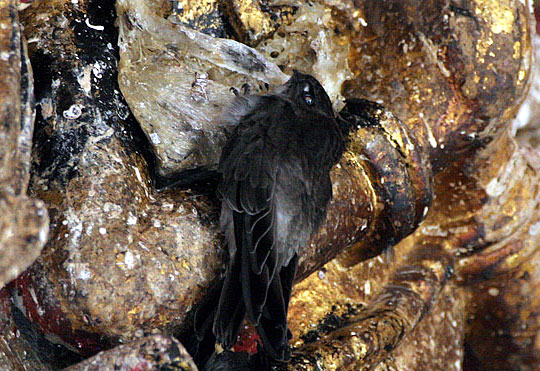Kingdom: Animalia Phylum: Chordata Class: Aves (Birds) Order: Apodiformes Family: Apodidae Tribe: Collocaliini |
Edible-nest Swiftlets are small, dark brown, slightly fork-tailed birds (size 12 cm). They are in many respects typical members of the Apodidae having narrow swallow-like wings for fast flight, with a wide gape and small reduced beak surrounded by bristles for hawking insects in flight. The breeding season is mainly March and April. The nests are white, opaque, 6 cm across and of the best commercial (edible) quality. During the breeding season, the salivary glands of this species expand to produce the special inspissated saliva for binding twigs and other detritus together for building the nest, which is a shallow cup stuck to the cave wall. Only those species whose nests are 'white' and made purely or almost purely of saliva are the most prized. The nests are harvested from cave walls. Edible Nests The Edible-nest Swiftlet is renowned for the fact that their nests are used for making bird's nest soup in Chinese cuisine. When cooked, the birds' nests have a gelatinous texture. In Chinese cuisine, high medicinal and aphrodisiac qualities are ascribed to these nests. Scientific investigations reveal these nests to be high in protein with about 7% lime. Many consumers of bird nest soup report significant improvement in appetite. However, some others noticed excessive secretion of gastric acid that may cause acid reflux symptoms. There is some concern that over-harvesting is causing several species of cave swiftlets to become scarce. Bird nest merchants in southeast Asia (including Vietnam, Indonesia, Thailand etc.) have started to raise and breed the swiftlets in house-like structures. They build the shelters to attract wild swiftlets to build nests in them. The wrong kind of nests are then destroyed along with the eggs inside. Over time, the selection process only leaves behind a colony of swiftlets that produce the right kind of nest for the trade. "House nests" are priced much lower than the "cave nests" due to the level of risks involved in the harvesting process.
Guano from the Swiftlets and the many bats that inhabit the caves supports an array of specialized
animals that feed on the dung. There are yet other creatures that have evolved to feed on these dung
eaters as well as the bats and the swiftlets themselves including among others, snakes that can climb
the sheer walls to snatch a passing meal and huge carnivorous crickets that prey on chicks and bat
pups. This ecosystem is totally self sustaining, the only link being the birds
and the bats that bring the nutrients into the caves in the first place. |
|

